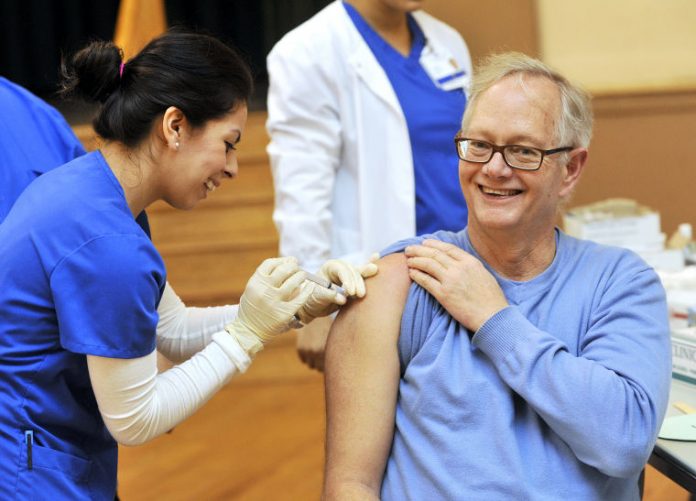
Even though San Benito County’s Public Health department waited until January to hold a free seasonal flu vaccination clinic, there was a line of about 50 people when they opened the doors of the Veterans Memorial Building at 1:30 p.m. on Tuesday, with a line forming again in the afternoon.
Public health had planned to offer 1,000 vaccines until 6 p.m., or when supplies ran out.
In past years, the public health department held a free flu vaccination clinic in the fall, with the last one held in November 2011. This year, the agency encouraged residents to get a vaccination from local pharmacies, a primary care physician or other sources.
Samela Perez, the public information officer for public health, said the clinic was offering Flu Mist for those ages six months old to 49, with a flu shot for those 50 and older.
“Today shows there is a need,” Perez said. “It is a great resource to get it free. For a large family, it can be expensive.”
Angie Gladstone, the immunization coordinator, said she puts in a request each year based on how many people they had the last season, but the state decides what the allocation will be for each county. In 2011, the county vaccinated 1,554 residents.
The clinic again served as a drill for county employees.
“We are doing random timing to determine how quickly we would be able to do it in an actual emergency,” Perez said. “We can figure out how long it takes to get people” vaccinated or treated with medication.
“It’s good for cross training just in case (someone) is not here,” she said, noting that an emergency situation could arise after work hours or on the weekends.
In addition to public health employees, county employees from other offices volunteered their time. Nurses from local hospitals, retired nurses and nursing students from Gavilan College administered the vaccinations.
Jeanie Simin, who works part-time with a school clinic, said she has been volunteering at the health clinic for years.
“It’s just fun doing it,” she said, after administering Flu Mist to a reluctant 2-year-old Isaac Rios.
As she squirted the mist into his nose, he squirmed in his mother’s lap.
Alvaro Garza, the medical officer for San Benito County, said the main goal of the clinic was to catch patients who for “whatever reason couldn’t get it.” He referred to drug stores and medical officers as the “first line.”
He said flu season generally runs from October to March so he encourages people who haven’t been vaccinated to continue to seek out a vaccination at a local pharmacy or medical clinic. He said the charges for vaccinations vary by location.
Garza also noted the importance of the clinic in providing a drill for employees.
“If and when there is a pandemic, we will need to protect as many people as possible,” he said, explaining that in an emergency there might be time to distribute medications or vaccines to each pharmacy or doctor’s office. “It is useful to go through and exercise the execution.”
In addition to getting a flu vaccination, Garza recommended those with flu-like symptoms stay home from school or work, washing hands frequently and sneezing or coughing into one’s sleeve to prevent further spread of the illness.
At the end of December, the Centers for Disease Control and Prevention started receiving regional reports of seasonal flu in California, Washington, Oregon and Arizona, along with two other states. Other states reported widespread cases of influenza, with Hawaii reporting sporadic cases.
Since Sept. 30, there have been 18 pediatric deaths related to influenza.
Garza said the seasonal flu vaccination can change year to year, with experts trying to determine what strains are likely to be most aggressive each season. This year’s vaccination includes protection against three viruses, including H1N1, which was included last season. The two new strains include H3N2 and B vaccine viruses.
“It’s not too late,” Garza said, of getting the vaccination into February or March.









